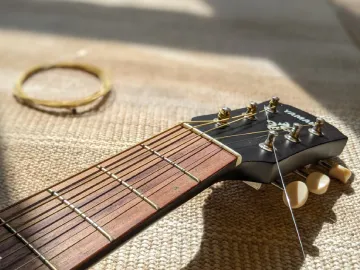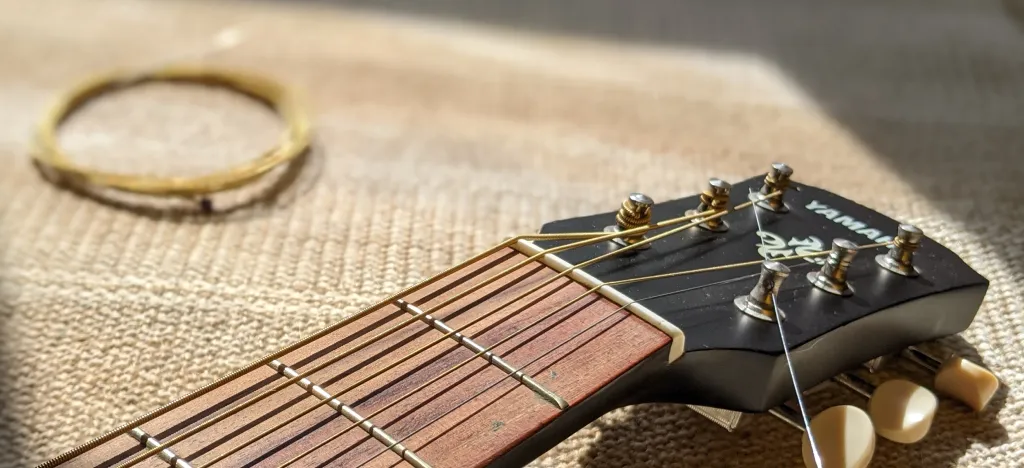If you’re a beginner guitarist, you might be apprehensive about changing the guitar strings yourself. While the process varies slightly between acoustic and electric guitars, it’s easy to learn and will soon become second nature.
In this quick, step-by-step guide, you’ll discover how to replace guitar strings on any guitar — including 12-string guitars — along with tips on choosing the best guitar strings. Plus, there’s a FREE video tutorial and expert tips to make the process simple. Let’s get started!
- Why replacing guitar strings matters
- What you'll need to replace guitar strings
- Step-by-step: How to string a guitar
- Free Video Tutorial: Changing an electric guitar string
- Stringing tips for different types of guitar
- Choosing the right guitar strings
- FAQs: Guitar string replacement
- Learn more about playing guitar
Why replacing guitar strings matters
Guitar strings wear out over time, affecting your sound, tuning, and overall performance. Whether you're strumming an acoustic guitar or shredding on an electric, fresh strings can make all the difference.
How often should you replace guitar strings?
Every 3-4 months for casual players
Every 1-2 months for regular players
Every few weeks for gigging musicians
Immediately if strings feel rough, look rusty, or constantly go out of tune
💡 ARTMASTER TIP: If you're using a 12-string guitar, expect to change strings more frequently due to added tension and complexity.
What you'll need to replace guitar strings
 Basically, all you really need is a spare guitar string (or set of strings), but as you develop as a guitarist you’ll definitely want to add a few things to your toolkit to make it even more effortless:
Basically, all you really need is a spare guitar string (or set of strings), but as you develop as a guitarist you’ll definitely want to add a few things to your toolkit to make it even more effortless:
New guitar string(s)
String winder (optional but helpful)
Wire cutters (to trim excess string)
Guitar tuner (for accurate tuning)
Bridge pin puller (for acoustic guitars)
Many string winders come with a bridge pin puller at the end. At a push, I have been known to pull the pins out gently with pliers (but I wouldn't recommend it).
💡 ARTMASTER TIP: If you don’t have a guitar tuner handy, just use our free guitar tuner. And be sure to check out our guide on how to tune a guitar.
Step-by-step: How to string a guitar
1. Remove old strings
Loosen the strings — Turn the tuning pegs counterclockwise to slacken each string.
Remove from the bridge — For acoustic guitars, use a bridge pin puller. For electric guitars, pull the string out through the bridge or tailpiece.
Discard old strings safely — Coiled wires can be sharp.
2. Install new guitar strings
Insert the string into the bridge — For acoustics, place the ball end into the bridge hole and secure with a bridge pin. For electrics, thread through the bridge or tailpiece.
Thread through the tuning peg — Pull the string through the peg hole, leaving some slack for winding.
Wind the string — Turn the tuning peg clockwise (or as needed), ensuring each coil winds neatly downward.
Tip for 12-string guitars: String in pairs, starting with the lowest octave strings and moving to the higher ones.
3. Tune and stretch the strings
Tune to pitch using a guitar tuner.
Stretch each string gently to help it settle and reduce future tuning issues.
Retune as needed — New strings often require multiple tuning passes.
💡 ARTMASTER TIP: Now that your strings are fresh and ready, it's time to start playing. If you're new to reading guitar music, check out our beginner’s guide to how to read guitar tabs — it’s the easiest way to start learning real songs today.
Free Video Tutorial: Changing an electric guitar string
Take a look at Dre Dimura's excellent free tutorial on how to change a guitar string.
Feeling inspired? Why not try out Dre DiMura’s complete Electric Guitar for Beginners course as part of our Free 7-day Trial?
Stringing tips for different types of guitar
When stringing an acoustic guitar -
Use a bridge pin puller to remove pins.
Insert the ball end of the string and secure with a pin.
Wind the string at the tuning peg and tune to pitch.
When changing electric guitar strings -
Thread the string through the bridge or tailpiece.
Wind the string at the tuning peg, ensuring neat coils.
Tune and stretch the string before final tuning.
Classical guitar strings
Nylon strings require knots at the bridge.
Wrap the string around the tuning peg securely.
Tune and stretch carefully, as nylon stretches more than metal.
What about changing 12-string guitar strings?
Follow the same steps as for 6-string guitars but string the octave and unison pairs accordingly.
Take your time — 12-string guitars require precision to maintain even tension.
💡 ARTMASTER TIP: Fresh strings can transform your guitar's feel and tone—but achieving the sound of your guitar heroes isn't just about new strings or expensive gear. It's about technique, touch, and understanding your instrument. Discover how to emulate iconic tones with what you already have: How to sound like your guitar heroes—even if you don’t have their gear
Choosing the right guitar strings
Choosing the right strings is key to achieving your ideal tone, playability, and overall guitar performance. Different guitars require different string types, and selecting the right set can make all the difference in how your guitar feels and sounds.
💡 Quick tips for choosing strings:
Lighter gauges = Easier playability and bending
Heavier gauges = Fuller tone and better sustain
Coated strings = Longer-lasting but slightly less bright
Match strings to your playing style—bright for strumming, warm for fingerpicking, and durable for heavy-handed players
Types of acoustic guitar strings
Acoustic guitars rely on string resonance for their rich, natural tone. Here are some top choices:
Phosphor bronze – Known for its warm tone, durability, and balanced sound.
80/20 bronze – Bright, crisp, and vibrant, perfect for cutting through a mix.
Coated strings – Designed for longevity, with a smooth feel and resistance to corrosion.
For 12-string guitars: Use light gauge strings to reduce tension, making tuning easier and minimizing strain on the guitar neck.
Types of electric guitar strings
Electric guitars depend on pickups to capture string vibrations, so material and flexibility matter:
Nickel-plated steel – Versatile and balanced, with bright highs and solid mids.
Pure nickel – Delivers a warm, vintage tone, ideal for blues and classic rock.
Stainless steel – Offers a bright, punchy sound with excellent durability and corrosion resistance.
Pro tip: Lighter gauge strings make bends and solos easier, while heavier gauges provide more sustain and fuller tone.
Types of classical guitar strings
Classical guitars use nylon strings, which produce a softer, mellow sound compared to steel strings.
Clear nylon – Bright and articulate, ideal for traditional classical music.
Silver-plated copper wound – Richer bass response and a balanced tone.
Fluorocarbon strings – Sharper attack and more projection, perfect for modern styles.
Note: Classical guitars require specific tying techniques at the bridge—avoid using steel strings, as they can damage the instrument.
Types of bass guitar strings
Bass guitars need thicker, heavier strings to deliver deep, resonant lows.
Roundwound strings – Bright, textured sound, great for rock, funk, and slap techniques.
Flatwound strings – Smooth feel with a deep, mellow tone, often used in jazz and blues.
Tapewound strings – Soft, warm sound with a unique vintage vibe.
Tip for bassists: Consider stainless steel for brighter tones or nickel for a warmer, more balanced sound.
💡 ARTMASTER TIP: If you want to sound smoother, faster, and more expressive, don’t miss our guide to essential guitar techniques every player should know. try these beginner-friendly songs — they’re fun, familiar, and perfect for building confidence.
FAQs: Guitar string replacement
How often should I change guitar strings?
Casual guitar players can change strings every 3 to 4 months. If you play regularly or perform, aim for every 1 to 2 months.
Signs you need new strings:
Dull or dead tone
Strings feel rough or sticky
Tuning problems
Fresh strings improve sound and playability.
Can I change just one string on my guitar?
Yes, you can. If a single string breaks or wears out, you can replace just that string. However, if the other strings are old or uneven in tone, it’s often better to replace the entire set for consistent sound and tuning stability.
Is it OK to reuse guitar strings?
You can reuse old strings in an emergency, but it’s not recommended. Used strings lose tone, stretch out, and are more likely to break. For best results, always use a fresh set.
What’s the difference between acoustic and electric guitar strings?
Acoustic guitar strings are typically made from bronze or phosphor bronze, designed for a bright, resonant tone that projects naturally. Electric guitar strings use nickel or steel, which work better with magnetic pickups to produce a strong, amplified sound.
Can I use electric guitar strings on an acoustic guitar?
No. Electric guitar strings lack the tension and resonance needed for acoustic guitars. Using them will result in a weak, dull sound and can negatively impact your guitar’s performance.
What are the best acoustic guitar strings for beginners?
Light gauge phosphor bronze strings are ideal for beginners. They’re easier to press down, gentler on the fingers, and produce a warm, balanced tone—perfect for learning chords and strumming techniques.
Can I use a D string as a G string (or as an A string)?
It’s possible, but not ideal.
As a G string, a D string will feel too tight and affect tuning.
As an A string, it’ll be too loose and may buzz.
Using the correct gauge helps keep your tone, tension, and tuning consistent.
How often should I change bass guitar strings?
Bass strings last longer than regular guitar strings. Casual players can change them every 6 months. Gigging or recording bassists may need new strings every 1 to 3 months. If your bass sounds dull, lacks definition, or feels sticky, it’s time to change them.
Learn more about playing guitar
Learn guitar online with one of our popular online guitar courses from beginner acoustic or electric guitar to colourful chord techniques and guitar soloing.
Try Our FREE 7-Day Trial!

About the author
Matt Ford is a musician, teacher, writer, and lifelong student of sound.
With years of experience in both performing and teaching, he shares practical advice through ArtMaster to help musicians at every level build skill and confidence in their playing.

